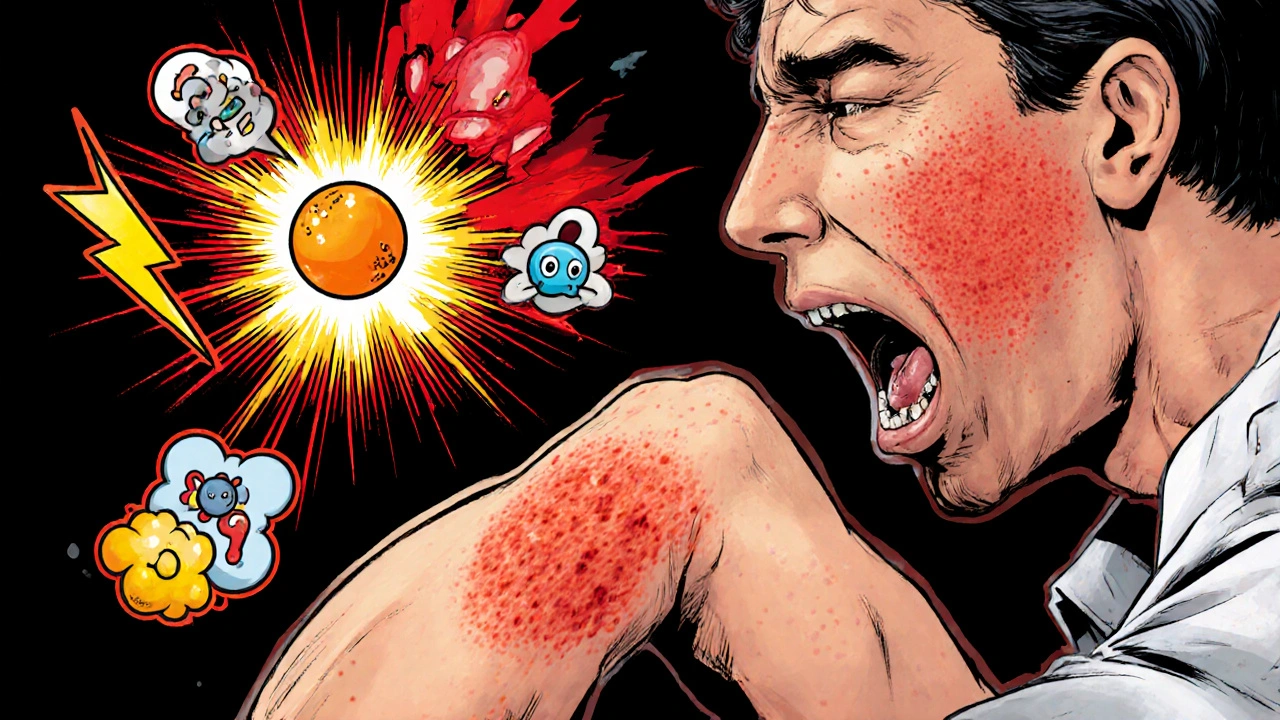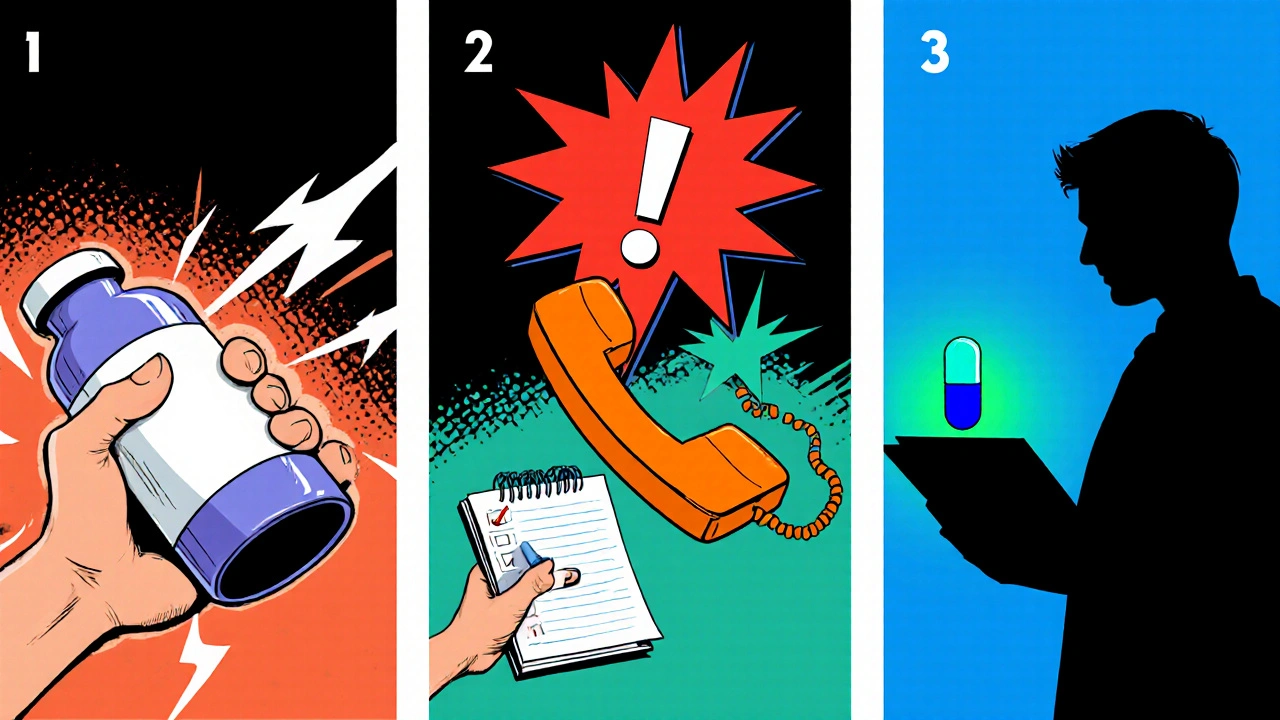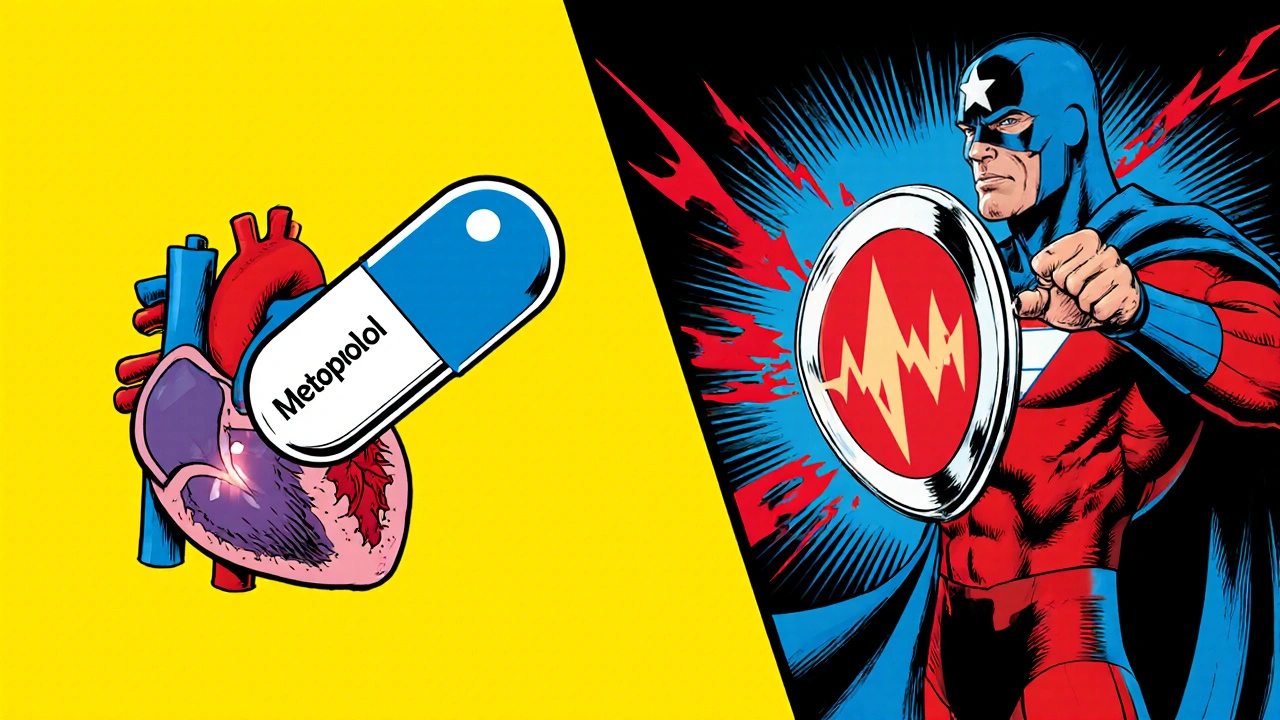Metoprolol Allergic Reaction Assessment Tool
Symptom Assessment
Answer these questions about your symptoms. This tool helps you determine if your symptoms could indicate an allergic reaction to Metoprolol.
Result
When you pick up a prescription for Metoprolol is a beta‑blocker medication used to treat high blood pressure, angina, and certain heart rhythm disorders, you probably focus on its heart‑health benefits and forget about the rare but real chance of an allergic reaction. This guide walks you through what to look for, why it happens, and exactly what to do if you start feeling off. Understanding the warning signs can keep a simple prescription from turning into a medical emergency.
What is Metoprolol and How Does It Work?
Metoprolol belongs to the beta‑blocker class, which slows the heart’s signal by blocking adrenaline receptors. By doing so, it lowers the force of each heartbeat, reduces blood pressure, and eases the workload on the heart. It comes in two main forms - immediate‑release (Tartrate) and extended‑release (Succinate) - and doctors tailor the dosage to conditions like hypertension, heart failure, or after‑heart‑attack care.
Typical vs. Allergic Reactions: Spot the Difference
Most patients feel minor side effects such as fatigue, cold hands, or a slower pulse. These are predictable and usually fade as the body adjusts. An allergic reaction, however, stems from the immune system flagging the drug as a threat and can look very different.
- Skin signs: hives (urticaria), red itchy patches, or a widespread rash that appears within minutes to hours after the dose.
- Respiratory cues: wheezing, shortness of breath, or a tightening sensation in the throat - especially concerning for people with asthma.
- Cardiovascular clues: sudden drop in blood pressure, rapid heartbeat (tachycardia) that feels out of sync with the drug’s purpose.
- Systemic signs: swelling of the lips, face, or tongue, and in the worst case, anaphylaxis, a life‑threatening emergency that demands immediate medical attention.
If any of these pop up after you start Metoprolol, treat them as a red flag rather than a typical side effect.
Why Do Allergic Reactions Occur?
Allergy isn’t a flaw in the drug; it’s a quirk of the immune system. In some people, the body creates IgE antibodies that latch onto Metoprolol molecules, triggering mast cells to release histamine. This cascade leads to the skin, airway, and vascular symptoms listed above. Cross‑reactivity can also play a role: if you’ve previously reacted to another beta‑blocker (like propranolol or atenolol), your immune system may mistake Metoprolol for its “cousin.”
Genetics, previous drug allergies, and underlying conditions such as asthma or chronic urticaria increase the odds. Studies in pharmacovigilance databases from 2022‑2024 show that about 0.02% of Metoprolol users report confirmed allergic events, a small number but enough to merit vigilance.

Who Is Most at Risk?
While anyone can develop a drug allergy, certain groups should keep a closer eye:
- Patients with a history of drug allergies - especially to other beta‑blockers or ACE inhibitors.
- Individuals with asthma or chronic allergic rhinitis - they already have hyper‑reactive airways, making respiratory symptoms more pronounced.
- People on multiple medications - polypharmacy raises the chance of an immune mix‑up.
- Elderly patients - metabolism changes can lead to higher blood levels, potentially exposing the immune system to more of the drug.
If you fall into any of these categories, discuss the risk with your healthcare provider before starting the pill.
Step‑by‑Step: What to Do If You Suspect an Allergy
- Stop the medication immediately. Do not wait for the next dose. \n
- Assess the severity. If you notice swelling of the face, lips, tongue, or difficulty breathing, call emergency services (000 in Australia) right away.
- Take an antihistamine. For mild skin symptoms, an over‑the‑counter antihistamine (cetirizine 10mg) can help while you arrange medical advice.
- Document the reaction. Note the time of the dose, the exact symptom, and any other medications you took that day.
- Contact your prescriber or pharmacist. Provide the details and ask for an alternative therapy - often a different class of blood‑pressure drug such as an ACE inhibitor or calcium‑channel blocker.
Never restart Metoprolol on your own after a suspected allergic event. Even a single dose can prime the immune system for a more severe reaction later.
Allergic Reaction vs. Common Side Effects: Quick Comparison
| Feature | Allergic Reaction | Typical Side Effect |
|---|---|---|
| Onset | Minutes to hours | Days to weeks |
| Skin | Hives, rash, itching | Mild itching or dry skin |
| Breathing | Wheezing, throat tightness, possible anaphylaxis | Occasional shortness of breath due to lowered heart rate |
| Blood Pressure | Sudden drop (hypotension) | Gradual lowering, generally stable |
| Severity | Potentially life‑threatening | Usually mild and self‑limiting |
The table helps you quickly decide whether you’re dealing with a harmless side effect or something that needs urgent care.

How to Talk to Your Doctor About a Suspected Allergy
Bring a clear, concise summary:
- Exact medication name and dose (e.g., Metoprolol Succinate 50mg daily).
- Time of symptom onset relative to the dose.
- Visual description or a photo of any rash.
- Any previous drug allergies, asthma history, or recent infections.
Most clinicians will perform a skin test or refer you to an allergist for a graded challenge. If Metoprolol must be avoided, they can switch you to a calcium‑channel blocker like amlodipine or an ACE inhibitor such as lisinopril, depending on your overall cardiovascular profile.
Key Takeaways
- Metoprolol allergies are rare but can present with rash, breathing trouble, or anaphylaxis.
- Watch for rapid onset symptoms that differ from the gradual fatigue or cold extremities usually seen with beta‑blockers.
- If you suspect an allergy, stop the drug, assess severity, and seek medical help immediately.
- People with prior drug allergies, asthma, or polypharmacy are at higher risk.
- Communicate clearly with your prescriber to find a safe alternative.
Frequently Asked Questions
Can Metoprolol cause a rash without an allergy?
Mild skin irritation can happen as a side effect, but true allergic rashes are usually itchy, raised hives that appear quickly after dosing. If the rash spreads or is accompanied by breathing trouble, treat it as an allergy.
Is it safe to take an antihistamine while on Metoprolol?
Yes, most over‑the‑counter antihistamines (like cetirizine) do not interact with beta‑blockers. However, avoid sedating antihistamines if you already feel unusually tired, as they can amplify Metoprolol’s fatigue.
What alternatives exist if I’m allergic to Metoprolol?
Depending on why you were prescribed Metoprolol, doctors may switch you to a calcium‑channel blocker (e.g., amlodipine), an ACE inhibitor (e.g., lisinopril), or even an ARB like losartan. Each class works differently, so a tailored plan is essential.
Do I need to carry an allergy card for Metoprolol?
If you have confirmed an allergic reaction, it’s wise to have a medical alert card or wear a bracelet stating “Allergic to Metoprolol - beta‑blocker allergy.” This helps emergency staff act quickly.
Can an allergy develop after months of use?
Yes. While many drug allergies appear early, delayed hypersensitivity can emerge after weeks or months of continuous exposure. Stay alert to new symptoms even if you’ve been stable for a long time.


Matthew Bates
October 15, 2025 AT 16:59Metoprolol, as a β‑blocker, exerts its therapeutic effect by antagonizing adrenergic stimulation of myocardial β₁‑receptors, thereby reducing chronotropy, inotropy, and ultimately systemic blood pressure. The pharmacokinetic profile differs between the tartrate immediate‑release and succinate extended‑release formulations, influencing peak plasma concentrations and dosing intervals. While the primary safety considerations involve bradycardia and hypotension, clinicians must also be vigilant for immunologic hypersensitivity reactions, albeit rare. Such reactions typically manifest within minutes to a few hours post‑dose and may include urticaria, angio‑edema, or bronchospasm. Prompt identification and cessation of the offending agent are essential to prevent progression to anaphylaxis. Documentation of the event, along with a thorough drug allergy history, facilitates appropriate alternative therapy selection. Ultimately, a balanced risk‑benefit assessment should guide Metoprolol initiation, especially in patients with pre‑existing atopic tendencies.
NANDKUMAR Kamble
October 18, 2025 AT 00:33There’s a lingering suspicion that the pharmaceutical industry downplays the prevalence of beta‑blocker allergies, preferring to emphasize cardiovascular benefits while quietly omitting rare hypersensitivity data from public disclosures. The very fact that case reports surface sporadically suggests an intentional obfuscation, leaving patients to discover adverse reactions only after severe episodes.
namrata srivastava
October 20, 2025 AT 08:06The immunopathogenesis of Metoprolol‑induced hypersensitivity can be delineated as a Type I IgE‑mediated cascade, wherein haptenization of the drug molecule precipitates cross‑linking of FcεRI‑bearing mast cells, effectuating degranulation and subsequent release of vasoactive mediators. Moreover, the molecular mimicry between β‑adrenergic antagonists may engender cross‑reactive epitopes, amplifying the immunogenic potential in predisposed phenotypes. Pharmacovigilance analytics from 2022‑2024 denote an incidence of approximately 0.02 % within the exposed cohort, underscoring the necessity for heightened clinical vigilance.
Priyanka arya
October 22, 2025 AT 15:39Yo, if you ever get that sudden itchy rash after a Metoprolol dose, don’t just brush it off – it could be an allergy, not just a side effect 😳. Grab an antihistamine, stop the pill, and call your doc ASAP. Staying chill is fine, but a swollen tongue is no joke! 🚑
Loren Kleinman
October 24, 2025 AT 23:13First, understand that drug allergies, while uncommon, can happen to anyone, even if you feel healthy. The body’s immune system sometimes misidentifies a medication as a threat and launches a defense. When Metoprolol is the trigger, the signs may include hives, swelling, or breathing trouble. These symptoms often appear quickly after you take the pill, which helps you separate them from normal side effects. If you notice any of these changes, stop the medication right away. Then, call emergency services if you have trouble breathing or swelling of the face or tongue. For milder skin reactions, an over‑the‑counter antihistamine can provide relief while you arrange a doctor’s call. Keep a written note of the exact time you took the dose and what happened next. This record will make it easier for your healthcare provider to understand what occurred. Share your full medication list, because other drugs can sometimes interact and worsen the reaction. Ask your doctor about alternative blood‑pressure medicines that do not belong to the beta‑blocker class. Options like calcium‑channel blockers or ACE inhibitors are often effective and may carry a lower allergy risk for you. Remember, never restart Metoprolol without medical supervision after an allergic event. Even one dose can sensitize your immune system for a stronger reaction later. Finally, consider wearing a medical alert bracelet that mentions your Metoprolol allergy, so emergency staff can act quickly.
Sabrina Goethals
October 27, 2025 AT 05:46Wow!!! That’s a solid rundown-thanks for breaking it down so clearly. I’m gonna keep a note on my phone, just in case. Super helpful!!
Benjie Gillam
October 29, 2025 AT 13:19From a pharmacodynamic perspective, Metoprolol’s β1‑selectivity confers a reduced incidence of bronchospastic events compared to non‑selective agents, yet the drug’s hapten formation can still precipitate IgE‑mediated responses. Clinicians should therefore employ a dual‑approach: monitor for cardiovascular metrics while also maintaining a high index of suspicion for cutaneous or respiratory hypersensitivity, especially in patients with documented atopic diathesis. If an allergic reaction is confirmed, a cross‑reactivity assessment with other adrenergic antagonists is advisable before selecting an alternative therapy.
Naresh Sehgal
October 31, 2025 AT 20:53Don’t sit around waiting for a rash to appear – be proactive! If you have any history of drug allergies, demand a skin test before you even get the prescription. Push your doctor for a clear alternative now, not later.
Poppy Johnston
November 3, 2025 AT 04:26Hey everyone, just wanted to say it’s totally okay to feel uneasy about a new med. Keep an eye on how you feel, and reach out to a friend or family member if you notice anything odd. You’ve got this!
Johnny VonGriz
November 5, 2025 AT 11:59Totally agree with Poppy – staying aware is key. If you’re ever in doubt, a quick call to your pharmacy can clear things up fast. No need to panic, just stay informed.
Real Strategy PR
November 7, 2025 AT 19:33Ignoring drug allergies is a reckless gamble with patient safety.
Doug Clayton
November 10, 2025 AT 03:06You’re not alone in this it happens and we’ll get through it together
Michelle Zhao
November 12, 2025 AT 10:39It is a lamentable truth that, despite the marvels of modern pharmacotherapy, the specter of hypersensitivity persists, casting a shadow over the otherwise laudable efficacy of Metoprolol; such an eventuality demands our unwavering vigilance and a steadfast commitment to patient safeguarding.
Eric Parsons
November 14, 2025 AT 18:13When evaluating Metoprolol for a patient with a known allergy to other beta‑blockers, consider ordering a graded drug challenge under allergist supervision. This approach can definitively determine cross‑reactivity and guide safe prescription practices.
Mary Magdalen
November 17, 2025 AT 01:46Our healthcare system should prioritize home‑grown, thoroughly tested meds over foreign imports that may hide hidden allergen profiles – we deserve transparency and safety, period!
Dhakad rahul
November 19, 2025 AT 09:19Behold, the elite circles whisper that only the truly informed discern these hidden drug perils; let the masses awaken 🌟😉